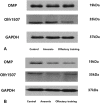The neuroplastic effect of olfactory training to the recovery of olfactory system in mouse model
- PMID: 30793525
- PMCID: PMC6767412
- DOI: 10.1002/alr.22320
The neuroplastic effect of olfactory training to the recovery of olfactory system in mouse model
Abstract
Background: Several studies have reported the benefits of olfactory training (OT) in the olfactory nervous system of mouse models. Therefore, in this study we performed next-generation sequencing to evaluate the effects of OT on mRNA sequencing in the olfactory area.
Methods: Mice in each group were administered 300 mg of 3-methylindole per kilogram of mouse weight. The olfactory function was evaluated by a food-finding test once a week. The olfactory neuroepithelium was harvested for histologic examination and protein analysis. Subsequently, data analysis, gene ontology and pathway analysis, quantitative real-time polymerase chain reaction of mRNA, and Western blot analysis were conducted.
Results: Mice were divided into 4 groups according to treatment. Control, anosmia, training, and steroid group mice resumed food finding. Olfactory Maker Protein, olfr1507, ADCY3, and GNAL mRNA expression was higher in the olfactory neuroepithelium of OT than anosmia group mice. In total, 26,364 mRNAs were analyzed. Comparison of the results of OT vs anosmia revealed that ADCY8,10, GFAP, NGF, NGFR, GFAP, and BDNF mRNAs were upregulated in the gene ontology.
Conclusion: OT improved olfactory function, as indicated by the food-finding test. OT improved the olfactory recovery time to stimulate olfactory nerve regeneration. OT may initially stimulate the olfactory receptor, followed by neurogenesis. Steroid therapy and OT operated under completely different mechanisms in the upregulated gene study. These results indicate that OT may be one of the future modalities for treating olfactory impairment.
Keywords: olfaction; olfactory disorders; quality of life.
© 2019 The Authors. International Forum of Allergy & Rhinology published by ARS-AAOA, LLC.
Figures







Similar articles
-
Differences in Mechanisms of Steroid Therapy and Olfactory Training for Olfactory Loss in Mice.Am J Rhinol Allergy. 2020 Nov;34(6):810-821. doi: 10.1177/1945892420930945. Epub 2020 Jun 20. Am J Rhinol Allergy. 2020. PMID: 32564682
-
Effect of ginkgo biloba and dexamethasone in the treatment of 3-methylindole-induced anosmia mouse model.Am J Rhinol. 2008 May-Jun;22(3):292-6. doi: 10.2500/ajr.2008.22.3167. Am J Rhinol. 2008. PMID: 18588762
-
Olfactory Ensheathing Cells Mediate Neuroplastic Mechanisms After Olfactory Training in Mouse Model.Am J Rhinol Allergy. 2020 Mar;34(2):217-229. doi: 10.1177/1945892419885036. Epub 2019 Nov 2. Am J Rhinol Allergy. 2020. PMID: 31680531 No abstract available.
-
Olfactory Dysfunction in Traumatic Brain Injury: the Role of Neurogenesis.Curr Allergy Asthma Rep. 2020 Jul 9;20(10):55. doi: 10.1007/s11882-020-00949-x. Curr Allergy Asthma Rep. 2020. PMID: 32648230 Review.
-
Olfactory training - Thirteen years of research reviewed.Neurosci Biobehav Rev. 2022 Oct;141:104853. doi: 10.1016/j.neubiorev.2022.104853. Epub 2022 Sep 5. Neurosci Biobehav Rev. 2022. PMID: 36064146 Review.
Cited by
-
Research Progress of Olfactory Nerve Regeneration Mechanism and Olfactory Training.Ther Clin Risk Manag. 2022 Mar 5;18:185-195. doi: 10.2147/TCRM.S354695. eCollection 2022. Ther Clin Risk Manag. 2022. PMID: 35281777 Free PMC article. Review.
-
Olfactory training: what is the evidence?Int Forum Allergy Rhinol. 2020 Nov;10(11):1199-1200. doi: 10.1002/alr.22681. Epub 2020 Sep 3. Int Forum Allergy Rhinol. 2020. PMID: 32776673 Free PMC article. No abstract available.
-
Olfactory training with essential oils for patients with post-COVID-19 smell dysfunction: A case series.Eur J Integr Med. 2023 Jun;60:102253. doi: 10.1016/j.eujim.2023.102253. Epub 2023 Apr 14. Eur J Integr Med. 2023. PMID: 37163157 Free PMC article.
-
The influence of olfactory experience on the birthrates of olfactory sensory neurons with specific odorant receptor identities.Genesis. 2024 Jun;62(3):e23611. doi: 10.1002/dvg.23611. Genesis. 2024. PMID: 38888221 Free PMC article. Review.
-
Effects of intranasal neural stem cells transplantation on olfactory epithelium regeneration in an anosmia-induced mouse model.Sci Rep. 2025 May 16;15(1):17015. doi: 10.1038/s41598-025-01358-8. Sci Rep. 2025. PMID: 40379695 Free PMC article.
References
-
- Damm M, Pikart LK, Reimann H, et al. Olfactory training is helpful in postinfectious olfactory loss: a randomized controlled multicenter study. Laryngoscope. 2014;124:826‐831. - PubMed
-
- Landis B, Giger R, Morabia A, et al. Olfaction: an epidemiological study on 1,046 subjects. Chem Senses. 2003;28:E33.
-
- Schwob JE, Youngentob SL, Ring G, Iwema CL, Mezza RC. Reinnervation of the rat olfactory bulb after methyl bromide‐induced lesion: timing and extent of reinnervation. J Comp Neurol. 1999;412:439‐457. - PubMed
-
- Deems DA, Doty RL, Settle RG, et al. Smell and taste disorders: a study of 750 patients from the University of Pennsylvania Smell and Taste Center. Arch Otorhinolaryngol Head Neck Surg. 1991;117:519‐528. - PubMed
-
- Seiden AM, Duncan HJ. The diagnosis of a conductive olfactory loss. Laryngoscope. 2001;111:9‐14. - PubMed
Publication types
MeSH terms
Substances
LinkOut - more resources
Full Text Sources
Other Literature Sources
Medical
Miscellaneous

